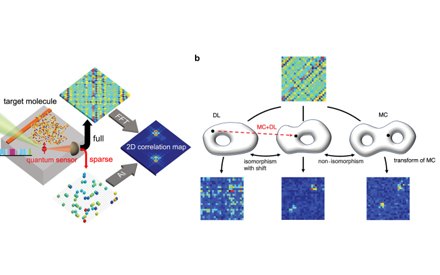
Another major breakthrough in quantum precision measurement! Help realize artificial intelligence algorithms to accelerate the detection of two-dimensional nano-NMR spectra
- Categories:Industry News
- Author:
- Origin:
- Time of issue:2020-08-18
- Views:0
(Summary description)Recently, Academician Du Jiangfeng of the Key Laboratory of Microscopic Magnetic Resonance of the University of Science and Technology of China, Professor Shi Development, etc. and Professor Wu Xiaodong of the University of Iowa have made new progress in the quantum precision measurement of the diamond nitrogen-vacancy (NV) color center system. Using the deep learning neural network method to accelerate the two-dimensional nano-NMR spectrum based on diamond quantum precision measurement technology, the detection efficiency is improved by nearly an order of magnitude. The research results are titled "Artificial intelligence enhanced two-dimensional nanoscale nuclear magnetic resonance spectroscopy" and published in "npj Quantum Information" in September 2020 [npj Quantum Information 6, 79 (2020)].
The analysis of the molecular structure of substances is an important means for the properties and functions of substances in chemistry and life science research. NMR is widely used in structural biology and clinical medicine due to its advantages of non-destructive, physiological conditions and even in-situ detection. Traditional NMR technology is limited by signal collection methods and can only measure collective signals generated by billions of molecular ensembles. In recent years, the diamond nitrogen-vacancy color center has been used as a magnetic sensor to realize nano-magnetic resonance spectroscopy.
The Key Laboratory of Microscopic Magnetic Resonance of the University of Science and Technology of China is in the direction of nano-NMR based on the NV color center, and on the optical detection magnetic resonance (ODMR) experimental platform, it is the first time to use a pair of coupled carbon-13 nuclear spins as the detection object to realize nano-two-dimensional NMR spectrum [Published in Adv. Quantum Technol. 2020, 3, 1900136 (2020) at the beginning of this year]. Due to the extremely weak microscopic NMR signal, in order to obtain a higher signal-to-noise ratio in the nanoscale two-dimensional NMR spectrum measurement experiment, it often takes a long time (several hours to days) to accumulate the signal. In order to improve the detection efficiency, the research team led by Du Jiangfeng applied artificial intelligence methods to the data processing and analysis of two-dimensional nuclear magnetic resonance spectroscopy, training deep learning neural networks through model data, and combining the matrix filling method, which finally made the time consumption Under 10% conditions, a nearly 4 times (~5.7dB) increase in signal-to-noise ratio can still be obtained.
The two-dimensional spectrum is the key to the analysis of spin distance and the basis of the analysis of single molecule structure. This work provides a universal method suitable for acceleration of two-dimensional nuclear magnetic resonance spectroscopy, which can be applied to the structure analysis of single molecules at the nanometer scale.
Associate Professor Kong Xi from Nanjing University, Dr. Zhou Leixin from the University of Iowa, and Li Zhijie, a doctoral student in the Key Laboratory of Micromagnetic Resonance, Chinese Academy of Sciences, are the co-first authors of this article. The research was funded by the Ministry of Science and Technology, the National Natural Science Foundation of China, the Chinese Academy of Sciences and Anhui Province.
Another major breakthrough in quantum precision measurement! Help realize artificial intelligence algorithms to accelerate the detection of two-dimensional nano-NMR spectra
(Summary description)Recently, Academician Du Jiangfeng of the Key Laboratory of Microscopic Magnetic Resonance of the University of Science and Technology of China, Professor Shi Development, etc. and Professor Wu Xiaodong of the University of Iowa have made new progress in the quantum precision measurement of the diamond nitrogen-vacancy (NV) color center system. Using the deep learning neural network method to accelerate the two-dimensional nano-NMR spectrum based on diamond quantum precision measurement technology, the detection efficiency is improved by nearly an order of magnitude. The research results are titled "Artificial intelligence enhanced two-dimensional nanoscale nuclear magnetic resonance spectroscopy" and published in "npj Quantum Information" in September 2020 [npj Quantum Information 6, 79 (2020)].
The analysis of the molecular structure of substances is an important means for the properties and functions of substances in chemistry and life science research. NMR is widely used in structural biology and clinical medicine due to its advantages of non-destructive, physiological conditions and even in-situ detection. Traditional NMR technology is limited by signal collection methods and can only measure collective signals generated by billions of molecular ensembles. In recent years, the diamond nitrogen-vacancy color center has been used as a magnetic sensor to realize nano-magnetic resonance spectroscopy.
The Key Laboratory of Microscopic Magnetic Resonance of the University of Science and Technology of China is in the direction of nano-NMR based on the NV color center, and on the optical detection magnetic resonance (ODMR) experimental platform, it is the first time to use a pair of coupled carbon-13 nuclear spins as the detection object to realize nano-two-dimensional NMR spectrum [Published in Adv. Quantum Technol. 2020, 3, 1900136 (2020) at the beginning of this year]. Due to the extremely weak microscopic NMR signal, in order to obtain a higher signal-to-noise ratio in the nanoscale two-dimensional NMR spectrum measurement experiment, it often takes a long time (several hours to days) to accumulate the signal. In order to improve the detection efficiency, the research team led by Du Jiangfeng applied artificial intelligence methods to the data processing and analysis of two-dimensional nuclear magnetic resonance spectroscopy, training deep learning neural networks through model data, and combining the matrix filling method, which finally made the time consumption Under 10% conditions, a nearly 4 times (~5.7dB) increase in signal-to-noise ratio can still be obtained.
The two-dimensional spectrum is the key to the analysis of spin distance and the basis of the analysis of single molecule structure. This work provides a universal method suitable for acceleration of two-dimensional nuclear magnetic resonance spectroscopy, which can be applied to the structure analysis of single molecules at the nanometer scale.
Associate Professor Kong Xi from Nanjing University, Dr. Zhou Leixin from the University of Iowa, and Li Zhijie, a doctoral student in the Key Laboratory of Micromagnetic Resonance, Chinese Academy of Sciences, are the co-first authors of this article. The research was funded by the Ministry of Science and Technology, the National Natural Science Foundation of China, the Chinese Academy of Sciences and Anhui Province.
- Categories:Industry News
- Author:
- Origin:
- Time of issue:2020-08-18
- Views:0

Scan the QR code to read on your phone
Related News
-
Another major breakthrough in quantum precision measurement! Help realize artificial intelligence algorithms to accelerate the detection of two-dimensional nano-NMR spectra
Recently, Academician Du Jiangfeng of the Key Laboratory of Microscopic Magnetic Resonance of the University of Science and Technology of China, Professor Shi Development, etc. and Professor Wu Xiaodong of the University of Iowa have made new progress in the quantum precision measurement of the diamond nitrogen-vacancy (NV) color center system. Using the deep learning neural network method to accelerate the two-dimensional nano-NMR spectrum based on diamond quantum precision measurement technology, the detection efficiency is improved by nearly an order of magnitude. The research results are titled "Artificial intelligence enhanced two-dimensional nanoscale nuclear magnetic resonance spectroscopy" and published in "npj Quantum Information" in September 2020 [npj Quantum Information 6, 79 (2020)]. The analysis of the molecular structure of substances is an important means for the properties and functions of substances in chemistry and life science research. NMR is widely used in structural biology and clinical medicine due to its advantages of non-destructive, physiological conditions and even in-situ detection. Traditional NMR technology is limited by signal collection methods and can only measure collective signals generated by billions of molecular ensembles. In recent years, the diamond nitrogen-vacancy color center has been used as a magnetic sensor to realize nano-magnetic resonance spectroscopy. The Key Laboratory of Microscopic Magnetic Resonance of the University of Science and Technology of China is in the direction of nano-NMR based on the NV color center, and on the optical detection magnetic resonance (ODMR) experimental platform, it is the first time to use a pair of coupled carbon-13 nuclear spins as the detection object to realize nano-two-dimensional NMR spectrum [Published in Adv. Quantum Technol. 2020, 3, 1900136 (2020) at the beginning of this year]. Due to the extremely weak microscopic NMR signal, in order to obtain a higher signal-to-noise ratio in the nanoscale two-dimensional NMR spectrum measurement experiment, it often takes a long time (several hours to days) to accumulate the signal. In order to improve the detection efficiency, the research team led by Du Jiangfeng applied artificial intelligence methods to the data processing and analysis of two-dimensional nuclear magnetic resonance spectroscopy, training deep learning neural networks through model data, and combining the matrix filling method, which finally made the time consumption Under 10% conditions, a nearly 4 times (~5.7dB) increase in signal-to-noise ratio can still be obtained. The two-dimensional spectrum is the key to the analysis of spin distance and the basis of the analysis of single molecule structure. This work provides a universal method suitable for acceleration of two-dimensional nuclear magnetic resonance spectroscopy, which can be applied to the structure analysis of single molecules at the nanometer scale. Associate Professor Kong Xi from Nanjing University, Dr. Zhou Leixin from the University of Iowa, and Li Zhijie, a doctoral student in the Key Laboratory of Micromagnetic Resonance, Chinese Academy of Sciences, are the co-first authors of this article. The research was funded by the Ministry of Science and Technology, the National Natural Science Foundation of China, the Chinese Academy of Sciences and Anhui Province. - Research Industry 2021-11-15
- Achitechive 2021-11-15
- Power Industry 2021-11-15
- Education Industry 2021-11-15
- Important progress in quantum precision measurement: a new method of nanoscale electrical detection based on NV color centers 2021-10-28
- Congratulations to the website of Anhui Guosheng Quantum Technology Co., Ltd. is online! 2021-09-30
- Important progress in quantum precision measurement: a new method for nanoscale electrical detection based on NV color centers 2021-09-30

Follow WeChat
Or search for "Guosheng Quantum"
More exciting waiting for you!
Contact:Yin Ying
Email:2891039951@qq.com
Add:3-4/F, Building b1, Zhong'an Chuanggu Science Park, No. 900, Wangjiang West Road, Shushan District, Hefei, Anhui
Anhui Guosheng Quantum Technology Co., Ltd. Copyright © 2021 All rights reserved 皖ICP备2021001781号 Powered by: 300.cn



 19505185126
19505185126 

 点击咨询
点击咨询 